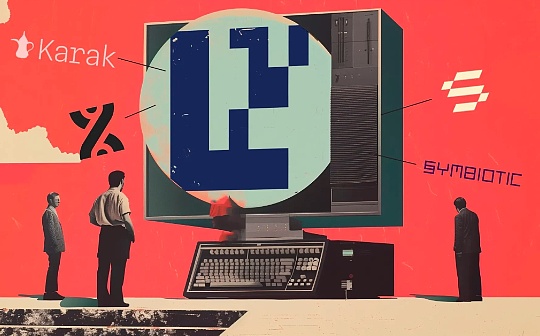Thoughts on ETH re-pledge

Reprinted from jinse
01/02/2025·3MArticle author: Larry Sukernik, Myles O'Neil Article compilation: Block unicorn
"If you could see yourself through my eyes" - Dermot Kennedy, "Lost"
We spend a lot of time researching re-hypothecation protocols at Reverie, an area that is attractive to us as it is full of uncertainty (opportunities often exist in ambiguous markets) and is very dynamic (next 12 Dozens of projects will be launched in the re-hypothecation field within the month).
In the course of our re-pledge work, we have made some observations about the future development of the re-pledge market. Many situations are emerging, so what is true today may not apply tomorrow. Nonetheless, we would like to share some of our initial observations on the business dynamics of the rehypothecation market.
LRT as leverage support
Today, LRTs (Liquidity Re-staking Tokens) like Etherfi/Renzo occupy a strong position in the re-staking supply chain: due to their proximity to both the supply side (stakers) and the demand side (AVS, referring to Active verification services), which are in a good position on both sides of the transaction. In this way, LRT (Liquidity Recollateralized Tokens) have the ability to (i) determine their rake ratio, and (ii) influence the rake ratio of the underlying market (such as EigenLayer, Symbiotic). Given their strong position, we can expect the re-hypothecation market to launch first-party LRTs to control the power of third-party LRTs.
AVS/rehypothecaters as leverage backing
The best markets in the world have two characteristics: a decentralized supply side and a decentralized demand side. To understand this intuitively, it helps to reflect on the opposite situation of concentration on the supply side or the demand side (or both) (AVS refers to Active Validation Nodes).
Imagine a simple apple trading market
Suppose there is a simple market for trading apples, in which the largest apple seller controls more than 50% of the apple supply. In this case, large Apple sellers may threaten to move their business elsewhere if the market operator decides to increase the market commission from 5% to 10%.
Likewise, on the demand side, if the largest apple buyer controls more than 50% of apple demand, she can also threaten to use other markets (or buy directly from apple suppliers) if the market operator increases the market rake words.
Back to the re-hypothecation market
If the final market structure of the rehypothecation market is concentrated on the AVS side (the top 10% of AVS account for more than 50% of the revenue) or the rehypothecater side (the top 10% of the rehypothecaters account for more than 50% of the deposits), then the natural The result is that the market's ability to extract itself will be reduced (and therefore the market's valuation should be reduced).
Although there is currently insufficient data to rigorously verify this, our intuition is that the power law distribution will apply here: large AVS will account for the majority of total payment volume, giving them bargaining power over the market cut.
Fight for exclusive AVS
From the perspective of every rehypothecation market, anything that can do something that competitors cannot do is worth trying. The simplest way to differentiate is to provide restakers with access to exclusive AVS – whether it’s a first-party AVS like EigenDA, or a third-party AVS acquired through an exclusive partnership. This is conceptually similar to Sony developing PS5 exclusive games to drive hardware sales.
Given these dynamics, we expect there will be some action in the rehypothecation market, such as the launch of more first-party AVS, or exclusive agreements with third-party AVS. In short, we will see a battle for AVS in the coming months.
AVS subsidy
AVS needs to pay the operator/re-stakeholder a fee for the services provided, which effectively means AVS needs to be prepared to pay in their native token, ETH/USDC, or possibly points/future airdrops. Having said that, since most AVS currently are early-stage startups without tokens, large balance sheets, or well-designed points programs/airdrops, signing up operators/re-stakeholders proves to be a cumbersome process ( Most EigenLayer partnerships are custom contracts negotiated privately).
Simply put, this is a situation where a customer wants to purchase a service, may be financially sound, but currently does not have sufficient funds.
In order to facilitate business development, the re-hypothecation market will likely make initial payments to operators/re-hypothecaters in advance, which can be through their native tokens, balance sheet assets, or by issuing "cloud points" to allow AVS to operate on the operator /Pay by spending money at the pledger. In return for upfront funds, AVS is expected to commit to airdropping tokens or allocating tokens to the restaking market. Alternatively, the rehypothecation market could advance this money to AVS to convince it to choose its own over a competing rehypothecation market.
In short, we expect the rehypothecation market to see intense competition over the next 12 to 24 months through subsidized AVS payouts. Similar to the market dynamics of Uber and Lyft, it may be the restaking market with the most funds/tokens that ultimately wins.
Personalized guidance
Going from "I want to launch an AVS" to actually putting it into production is not as simple as it seems, especially for a small team without a lot of R&D resources. Questions the team needs to address include how much security to buy, how long to buy security for, how much to pay the operator/re- stakeholder, what should be the penalty, and how much?
Best practices will eventually emerge, but until then, the restaking market will need to guide the AVS team through these issues (it’s worth noting that EigenLayer currently has no payment or penalty mechanisms).
To this end, we expect the winning rehypothecation market to be similar to enterprise sales operations, providing customers with personalized guided integration/service assistance so they can smoothly onboard the product.
Development of AVS
The most successful AVS may gradually move away from the restaking market and start using their own tokens or revenue to purchase security. Today, the incentives for restaking markets are most important for smaller projects that don’t have enough time, money, brand, or connections to recruit a validator set. But as projects scale, they may shift to recruiting their own validators and using their own more valuable tokens to secure the network. This situation is similar to the stages of market development, where the most successful customers gradually develop independently, and market operators need to be prepared for this.
A one-stop shop for crypto SaaS
To illustrate this observation, let’s start with a bit of software history: Cloud service providers like AWS give developers easy access to everything they need to launch an application or network service (e.g., hosting, storage, and compute) . By drastically reducing the cost and time required to develop software, a more specialized class of web services emerged. Cloud service providers combine first-party cloud services with a host of "microservices" provided within the platform, making it a one-stop shop for everything you need except core business logic.
Rehypothecation marketplaces like EigenLayer aim to build a similar set of microservices for Web3. For example, before EigenLayer, cryptographic microservices could fully centralize their offline components (and pass this risk on to their customers) or bear the cost of bootstrapping a set of operators and economic shares to purchase security.
Rehypothecation Market may break this microservices trade-off - if it works as intended, you'll be able to prioritize security without sacrificing cost and speed to market.
Let's say you are developing a cheap, high-performance zk-rollup. If you go to a restaking marketplace like EigenLayer, you will have multiple core service options like DA and bridging for easy onboarding. Through this process you will see dozens of other AVS microservices that you can integrate with.
The more microservices a rehypothecation market offers, the better the experience for customers - instead of having to evaluate the service features and security of dozens of independent vendors, applications will be able to purchase all needed services from one rehypothecation market . Therefore, users may come because of X service, but stay because of Y and Z services.
Some AVS will have network effects (e.g. preconfs/preconfigurations)
To date, restaking use cases have primarily focused on exporting Ethereum’s validator and economic share. But there is another class of “inward-focused” restaking use cases that can add functionality to Ethereum’s consensus without requiring changes to the protocol.
The idea is very simple – allow validators to choose to make additional commitments on proposed blocks in exchange for a payment, and be held accountable through penalties if they don’t fulfill those commitments. We suspect that only a few pledge types will have enough demand to attract high levels of engagement, but the amount of value flowing through these pledges can be substantial.
Unlike “external” re-staking use cases, the effectiveness of this type of use case is directly tied to validator participation. That is, even if you are willing to pay to be included in a block, it is not of much use if only 1 in 10 validators choose to honor that promise.
However, if every validator chooses a given commitment, then the guarantees behind it will be equivalent to the guarantees provided by the Ethereum protocol itself (i.e. valid blocks). Following this logic, we can expect strong network effects in this category, as users of AVS will benefit from every marginal validator that opts in to the pledge market.
Although this AVS category is still in its early stages, a logical distribution channel to facilitate these use cases may be through Ethereum client helpers and plugins (e.g., Reth). Similar to the separation of proposers from builders, it seems likely that proposers will outsource this work to dedicated players in exchange for a share of the revenue.
What is unclear is what form these AVS will take. While it's possible that one entity could create a general marketplace for any type of commitment, we suspect it's more likely to see a few focused on demand sources (e.g., L2 vs. L1 DeFi driven demand for interoperability). participants appear.




